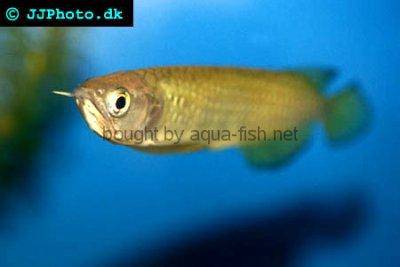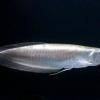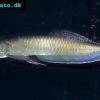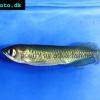Gulf saratoga - Scleropages jardinii
Scientific name: Scleropages jardinii
Common name: Gulf saratoga
Family: Osteoglossidae
Usual size in fish tanks: 90 - 100 cm (35.43 - 39.37 inch)
014
Recommended pH range: 6.2 - 7.2
Recommended water hardness: 4 - 18°N (71.43 - 321.43ppm)
0°C 32°F30°C 86°F
Recommended temperature range: 22 - 26 °C (71.6 - 78.8°F)
The way how these fish reproduce: Spawning
Where the species comes from: Oceania
Temperament to its own species: aggressive/territorial
Temperament toward other fish species: aggressive to smaller
Usual place in the tank: Top levels
Short description
The Gulf saratoga (Scleropages jardinii)—also called the Australian pearl arowana or Australian bonytongue—is a powerful, surface-oriented predator native to northern Australia and southern New Guinea. It is notoriously territorial and solitary, especially toward conspecifics and similar long, surface-dwelling fish. Juveniles may look manageable, but adults become large, muscular, and extremely jump-prone, demanding a very large, tightly covered aquarium with strong filtration and ample open swimming space.
Origin
Endemic to Oceania: coastal rivers, floodplains, billabongs, and lagoons of northern Australia (including Gulf of Carpentaria drainages) and parts of southern New Guinea. It favors warm, slow to moderate waters with heavy seasonal fluctuations and overhanging vegetation.
Food and feeding
A strict carnivore that can be trained to prepared foods. Start with prawns, fish fillets, insects (crickets, roaches), and seafood mixes; then wean to high-quality floating carnivore pellets/sticks. Avoid feeder fish (parasites/nutrition issues) and mammalian meats (fatty, indigestible long-term). Offer varied portions once or twice daily; remove leftovers to keep water pristine.
Sexing
No reliable external differences are known. Sex is difficult to determine without venting or confirmed breeding pairs.
Breeding
Scleropages jardinii is a paternal mouthbrooder: the male carries eggs and larvae in his mouth for roughly 5–7 weeks, releasing free-swimming fry when they reach a robust size. Home-aquarium spawning is exceptionally rare due to the species’ size, aggression, and space requirements; successful programs use very large ponds and environmental cues.
Lifespan
With excellent care, filtration, and space, expect 15–20 years.
Behavior & compatibility
Best kept as a single specimen. Adults are aggressive toward conspecifics and often toward similarly shaped fish (other arowanas, needlefish, gars). If tank mates are attempted (only in very large aquaria), choose robust, non-surface species too large to be swallowed (e.g., large armored catfish) and provide clear vertical and horizontal separation. Be prepared to separate at short notice.
Tank requirements
- Tank size: far beyond typical home aquaria. Think massive, long-footprint systems (≥800–1000 L for a single adult as a pragmatic minimum; larger is strongly recommended).
- Aquascape: wide open surface lanes; use sturdy driftwood/rock low in the tank; avoid sharp décor. Plants are optional and may be uprooted.
- Cover: escape-proof lid with weight/clamps—this species is an athletic jumper.
- Water: warm, clean, well-oxygenated; pH roughly 6.2–7.2; soft to moderately hard.
- Filtration: oversized bio-mechanical filtration (sump/canisters) and frequent large water changes; saratoga are heavy waste producers.
Scleropages jardinii (Gulf saratoga) is an extreme jumper. Use a tight-fitting, escape-proof lid with weight or clamps. Seal all gaps (cables, corners, feeding ports) and leave a safe air gap between the waterline and the lid.
Most jumps happen during startle responses (lights on/off, sudden movement), nighttime, or feeding splashes. Keep the surface clear for runway and avoid tall, sharp décor near the top.
Check condensation trays and hinges regularly. Replace warped lids immediately and keep parameters stable to reduce skittish behavior.
Pictures
Bought by aqua-fish.net from jjphoto.dk.






 Silver
Silver  Black
Black  Saratoga
Saratoga